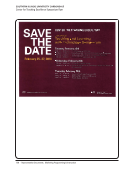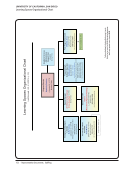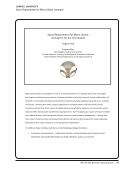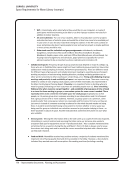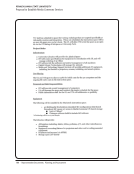SPEC Kit 342: Next-Gen Learning Spaces · 31
for formal classroom learning, but the events often include informal learning and are a new service capability the library
can provide. Most libraries have not had a significant change in services due to learning spaces.
This has enabled us to conduct instruction sessions and vendor database demonstration lectures in the library that
previously would have had to take placed elsewhere on campus, along with better satisfying our students’ request for
additional collaborative work space.
This includes the Research and Writing Center, converting a periodicals room into a grand reading room, and converting
the general reference area into a Learning Commons.
We have combined three reference service points into one at our main library.
We now staff combined reference and tech help desk. We have roaming library staff covering floors. We have added an
Ask Me desk in library lobby to quickly answer directional questions. These have all been driven by reconfigured spaces,
which have driven more students into the library.
We removed media reserves to open stacks and focus service desk on training and tech support.
We’ve added multimedia equipment for loan with the addition of a Mac Lab that has multimedia software. We are
in the process of adding a Tech Desk on our 2nd floor to help support our expanding collaborative spaces and the
technology within them, assist with the use of our presentation practice room, and house newer technologies like 3D
printing. Many of our individual and group study rooms require a key that is checked out at the circulation desk, but we
have been experimenting with online room reservation systems and open rooms that would allow students to control
when they use the spaces. This has taken a bit of the burden off of our circulation staff—fewer keys to check out and
students are monitoring the reservations themselves. Students are also requesting access to study spaces 24 hours a
day, and in response to this we have opened our lobby 24/5 during the regular semesters. To make the space more of a
study space we have invested in larger tables with bigger work surfaces, made power easier to access, and opened the
Collaboration Lab which houses computers and whiteboards.
EFFECT OF LEARNING SPACES ON LIBRARY STAFF
6. Has the development of learning spaces within your library had a direct effect on staff
responsibilities or positions? N=72
Yes 65 90%
No 7 10%
If yes, please indicate the type(s) of staff changes that have resulted from the development of
learning spaces. Check all that apply. N=65
Staff Changes Librarians Archivists Support staff N
Change in responsibilities 52 8 61 63
New position(s) created 32 2 41 49
Position(s) shared with external departments 7 0 18 22
Position(s) eliminated 4 0 14 15
Other staff change(s) 2 1 7 7
Total Responses 54 10 64 72
for formal classroom learning, but the events often include informal learning and are a new service capability the library
can provide. Most libraries have not had a significant change in services due to learning spaces.
This has enabled us to conduct instruction sessions and vendor database demonstration lectures in the library that
previously would have had to take placed elsewhere on campus, along with better satisfying our students’ request for
additional collaborative work space.
This includes the Research and Writing Center, converting a periodicals room into a grand reading room, and converting
the general reference area into a Learning Commons.
We have combined three reference service points into one at our main library.
We now staff combined reference and tech help desk. We have roaming library staff covering floors. We have added an
Ask Me desk in library lobby to quickly answer directional questions. These have all been driven by reconfigured spaces,
which have driven more students into the library.
We removed media reserves to open stacks and focus service desk on training and tech support.
We’ve added multimedia equipment for loan with the addition of a Mac Lab that has multimedia software. We are
in the process of adding a Tech Desk on our 2nd floor to help support our expanding collaborative spaces and the
technology within them, assist with the use of our presentation practice room, and house newer technologies like 3D
printing. Many of our individual and group study rooms require a key that is checked out at the circulation desk, but we
have been experimenting with online room reservation systems and open rooms that would allow students to control
when they use the spaces. This has taken a bit of the burden off of our circulation staff—fewer keys to check out and
students are monitoring the reservations themselves. Students are also requesting access to study spaces 24 hours a
day, and in response to this we have opened our lobby 24/5 during the regular semesters. To make the space more of a
study space we have invested in larger tables with bigger work surfaces, made power easier to access, and opened the
Collaboration Lab which houses computers and whiteboards.
EFFECT OF LEARNING SPACES ON LIBRARY STAFF
6. Has the development of learning spaces within your library had a direct effect on staff
responsibilities or positions? N=72
Yes 65 90%
No 7 10%
If yes, please indicate the type(s) of staff changes that have resulted from the development of
learning spaces. Check all that apply. N=65
Staff Changes Librarians Archivists Support staff N
Change in responsibilities 52 8 61 63
New position(s) created 32 2 41 49
Position(s) shared with external departments 7 0 18 22
Position(s) eliminated 4 0 14 15
Other staff change(s) 2 1 7 7
Total Responses 54 10 64 72










































































































































